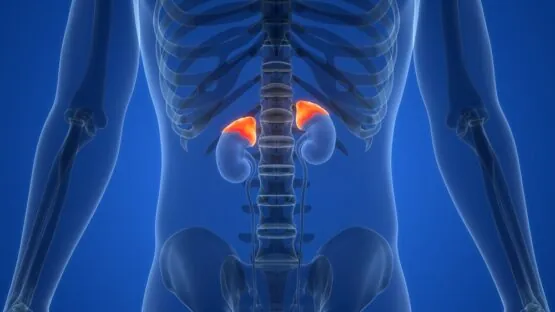In the Journal of Endocrinological Investigation, reviewers have described how aging affects the adrenal glands, which has downstream effects on the rest of the human body.
Small but vital
This paper begins with an in-depth description of the anatomy of the adrenal glands, which sit atop the kidneys, and the various hormones that each of their four zones produces; only the inner portion of these glands is responsible for adrenaline itself. The levels of these hormones vary with aging; some are elevated and others are reduced.
This work focuses on one compound in particular. Many tissues, including the adrenal glands, produce the biologically active DHEA, an androgenic steroid that is a precursor to testosterone, but only the zona reticularis of the adrenal glands sulfates it into DHEAS [1]. Production of this hormone is surprisingly rapid before birth, but it falls dramatically after birth until the age of five [2]. Its levels are highest in teenagers and young adults, with men having more than women; after the age of sixty, a man might have a tenth to a fifth of his younger level [3]. Under normal circumstances, levels of DHEA fluctuate during the day, but with aging, that rhythm is disrupted [2].
DHEA fulfills multiple roles within the human body: it has a natural antidepressant function and improves brain performance [2] and it has effects on the immune system, although they are complex and are modulated by other hormones [4]. Low DHEAS levels are associated with increased severity of arthritis and breast cancer along with increased mortality [2] and brain pathologies, including Alzheimer’s [5].
However, these are associations rather than causative proofs, and a lot of work involving DHEA supplements has reached negative or inconclusive results. Four separate studies focusing on daily living found that DHEA supplements provide no tangible benefit. Older women, who are at risk of osteoporosis, may have benefits in bone health, but there is no benefit in this area for men [6]. It also may benefit arterial health [7], although the extent is unclear.
These reviewers suggest that short time periods, a focus on healthy participants, and small sizes prevented most DHEA research from providing useful information.
Other hormonal and physical changes
In non-human primates, previous work has found that all the zones of the adrenal glands are impacted by senescence, as evidenced by increasing amounts of the biomarker p21 along with an increase in amyloid-β peptides, which are seldom discussed outside the context of Alzheimer’s. Signs of inflammaging, such as increased numbers of T cells and macrophages, are present as well [8]. These reviewers note that few examinations of human adrenal glands have been carried out, and they urge more work in this area.
The adrenal glands also produce corticosteroids, most notably the stress hormone cortisol. Under normal circumstances, this hormone spikes in the morning and is low in the evening, and it serves a very wide variety of bodily functions, including dealing with fats and reducing inflammation [9].
Unlike DHEA, however, cortisol levels somewhat increase about 20 to 50 percent between the ages of 20 and 80. While there is still a diurnal rhythm, it is less pronounced and shifted forward with age [10]. However, this may be due to inflammaging and other stressors [11], and while the brain’s receptiveness to cortisol has been found to diminish with aging in animal models [12], the increased levels are correlated with a great many problems, including failures of memory and reduced brain volume [13].
The researchers also point to associations between cortisol and other issues, such as diabetes, although they acknowledge that this work is largely inconclusive; for example, there appears to be no link between cortisol and body mass index. However, confirming common wisdom, elevated cortisol appears to be connected with an increase in blood pressure [14].
It is unclear if another hormone, aldosterone, increases or decreases with age. Some work has found a decrease [15], while other work has found an increase that is explainable by a migration of function from one part of the adrenal glands to another; a system that fluctuates in response to stimuli may be replaced by a constant flow with aging [16].
This is a review article, and it did not provide any novel research on its own. However, the collected information paints a picture of a fairly well-known but poorly explored target. The reviewers believe that adrenal aging should be considered an age-related pathology with its own diagnosis and disease stages, which would provide a framework for future interventions. As the adrenal glands are responsible for hormones throughout the body, their proper function may be key in preventing imbalances and damage in seemingly unrelated organs.
Literature
[1] Samaras, N., Samaras, D., Frangos, E., Forster, A., & Philippe, J. (2013). A review of age-related dehydroepiandrosterone decline and its association with well-known geriatric syndromes: is treatment beneficial?. Rejuvenation research, 16(4), 285-294.
[2] Arlt, W. (2004). Dehydroepiandrosterone and ageing. Best Practice & Research Clinical Endocrinology & Metabolism, 18(3), 363-380.
[3] Orentreich, N. O. R. M. A. N., Brind, J. L., Vogelman, J. H., Andres, R., & Baldwin, H. O. W. A. R. D. (1992). Long-term longitudinal measurements of plasma dehydroepiandrosterone sulfate in normal men. The Journal of Clinical Endocrinology & Metabolism, 75(4), 1002-1004.
[4] Prall, S. P., & Muehlenbein, M. P. (2018). DHEA modulates immune function: a review of evidence. Vitamins and hormones, 108, 125-144.
[5] Quinn, T., Greaves, R., Badoer, E., & Walker, D. (2018). DHEA in prenatal and postnatal life: implications for brain and behavior. Vitamins and hormones, 108, 145-174.
[6] Lin, H., Li, L., Wang, Q., Wang, Y., Wang, J., & Long, X. (2019). A systematic review and meta-analysis of randomized placebo-controlled trials of DHEA supplementation of bone mineral density in healthy adults. Gynecological Endocrinology.
[7] Weiss, E. P., Villareal, D. T., Ehsani, A. A., Fontana, L., & Holloszy, J. O. (2012). Dehydroepiandrosterone replacement therapy in older adults improves indices of arterial stiffness. Aging cell, 11(5), 876-884.
[8] Wang, Q., Wang, X., Liu, B., Ma, S., Zhang, F., Sun, S., … & Zhang, W. (2024). Aging induces region-specific dysregulation of hormone synthesis in the primate adrenal gland. Nature Aging, 4(3), 396-413.
[9] Yiallouris, A., Filippou, C., Themistocleous, S. C., Menelaou, K., Kalodimou, V., Michaeloudes, C., & Johnson, E. O. (2024). Aging of the adrenal gland and its impact on the stress response. In Vitamins and Hormones (Vol. 124, pp. 341-366). Academic Press.
[10] Van Cauter, E., Leproult, R., & Kupfer, D. J. (1996). Effects of gender and age on the levels and circadian rhythmicity of plasma cortisol. The Journal of Clinical Endocrinology & Metabolism, 81(7), 2468-2473.
[11] Moffat, S. D., An, Y., Resnick, S. M., Diamond, M. P., & Ferrucci, L. (2020). Longitudinal change in cortisol levels across the adult life span. The Journals of Gerontology: Series A, 75(2), 394-400.
[12] Lee, S. Y., Hwang, Y. K., Yun, H. S., & Han, J. S. (2012). Decreased levels of nuclear glucocorticoid receptor protein in the hippocampus of aged Long-Evans rats with cognitive impairment. Brain research, 1478, 48-54.
[13] Ferrari, E., Cravello, L., Falvo, F., Barili, L., Solerte, S. B., Fioravanti, M., & Magri, F. (2008). Neuroendocrine features in extreme longevity. Experimental Gerontology, 43(2), 88-94.
[14] Di Dalmazi, G., Fanelli, F., Zavatta, G., Ricci Bitti, S., Mezzullo, M., Repaci, A., … & Pagotto, U. (2019). The steroid profile of adrenal incidentalomas: subtyping subjects with high cardiovascular risk. The Journal of Clinical Endocrinology & Metabolism, 104(11), 5519-5528.
[15] Hegstad, R., Brown, R. D., Jiang, N. S., Kao, P., Weinshilboum, R. M., Strong, C., & Wisgerhof, M. (1983). Aging and aldosterone. The American journal of medicine, 74(3), 442-448.
[16] Nanba, K., Vaidya, A., & Rainey, W. E. (2018). Aging and adrenal aldosterone production. Hypertension, 71(2), 218-223.




